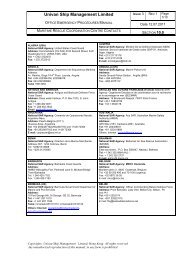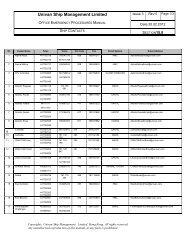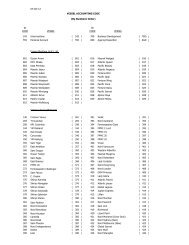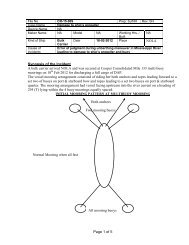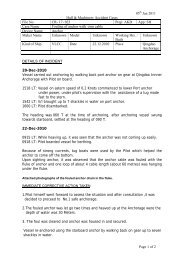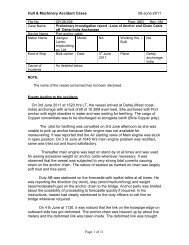Section: 11 CARGO OPERATIONS - Univan
Section: 11 CARGO OPERATIONS - Univan
Section: 11 CARGO OPERATIONS - Univan
You also want an ePaper? Increase the reach of your titles
YUMPU automatically turns print PDFs into web optimized ePapers that Google loves.
<strong>Univan</strong> Ship Management Limited Issue 1 REV 0 Page<br />
6/8<br />
FLEET OPERATION MANUAL Date 01.01.2005<br />
CONTAINER TYPES AND ASSOCIATED PROBLEMS<br />
Copyrights: <strong>Univan</strong> Ship Management Limited, Hong Kong. All rights reserved<br />
Any unauthorized reproduction of this manual, in any form is prohibited<br />
SECTION <strong>11</strong>.7<br />
at the time of stuffing, and accordingly, they are incapable of freezing a cargo which is not already<br />
in a frozen state. Pre-cooling of the container, and indeed the cargo, to the required temperature<br />
is usually critical, but it is often thought that setting the container temperature at a lower<br />
temperature than that required for carriage will give speedier cooling. This is not the case, the<br />
rate of cooling will not be significantly different and there is the risk that the lower temperature will<br />
result in frosting damage to cargo. The ventilation openings on reefer containers can also be a<br />
source of problems, and it is often the case that these are not in the correct position for the cargo<br />
being carried. Most refrigerated loads (especially fruit), with the exception of frozen goods, fresh<br />
meat, and non-organic goods such as photographic film, require air exchange to reduce carbon<br />
dioxide (CO2) build up and remove enzymes which speed up ripening. For frozen cargoes the<br />
ventilation openings should always be closed.<br />
The actual functioning of the reefer equipment is also a source of many problems. There are<br />
numerous accounts of units not being plugged into their power/cooling source correctly, or at all,<br />
or being inadvertently unplugged. This is as much a problem off the ship as it is on, and carriers<br />
should be aware of their period of responsibility for the goods and in any case ensure that a<br />
supervised regime of manual inspections is rigidly enforced. Reefer system failure is also a<br />
problem and pre-trip inspections (PTI) should be thorough. Appropriate spares and knowledge<br />
should be available on board to effect repairs. The interior fitness of reefer containers is essential,<br />
and there are numerous instances where cargo has been contaminated or otherwise damaged<br />
due to improper or insufficient cleaning and/or removal of previous cargo remnants including<br />
odours.<br />
Other common sources of problem lie with temperature setting, recording devices and stowage<br />
arrangements. Incorrect temperature setting is a common occurrence and even when this has<br />
been done by the shipper, the carrier’s responsibility may become involved if the set temperature<br />
is not checked against bill of lading and shipping/booking instructions. Temperature records are<br />
invariably of great importance and enormous difficulties can arise when recording devices are not<br />
working. Partlow charts are in common use, and each individual chart can record for up to 31<br />
days. It is often the case that the charts are not replaced or filled in correctly, i.e., with start time,<br />
container number, set temperature, etc., or that the clockwork mechanism is not activated.<br />
Temperature monitoring is not so much a problem but a burden and a necessary one. The<br />
problem arises when monitoring has not been done and/or records are not kept. As to stowage, it<br />
is often found that arrangements within the container are not suitable for the type of refrigerated<br />
cargo concerned.<br />
<strong>11</strong>.7.8 Bulk Containers.<br />
These general purpose type containers can carry dry powders and granular cargoes in bulk. Top<br />
loading is via hatches fitted in the roof and discharge (which requires a tipping trailer) is via a<br />
hatch fitted in the door. Mild steel floors are commonly fitted to enable easy cleaning. Tank<br />
containers for dry bulk cargoes are also in use, but give lower payload capacities than the box<br />
design (for a TEU, around 33.1 cbm for the former and 19.3 cbm for the latter).<br />
The main problems these units encounter are water ingress and condensation. Care must be<br />
taken particularly with fine powders, where the inadvertent opening of hatches has been known to<br />
cause product loss, especially in windy conditions.



